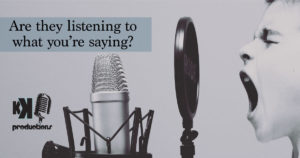Some time ago, it dawned on me that I should start looking at commercial audio production in the same manner that advertisers approach the Super Bowl. It’s not just a commercial. In 1977, Xerox aired the first Super Bowl commercial that became viral. It was the first commercial that got people requesting to see it over and over again on TV. Today, more people tune in to the Big Game for the commercials, not because of football.
So what does that tell you about an audience? It tells me that they want to be entertained. It also tells me that people will pay attention when they know something is about to happen that will make them laugh, make them cry, make them think and get them talking. Why in the world would they tune in otherwise?
Have you ever noticed that the media hype after the Super Bowl is more about the commercials than it is about the actual game? Nobody is going to YouTube to watch their favorite team win or lose…again, they are going back to watch the commercials everyone is talking about. In fact, so much so that these commercials are ranked from best to worst every year.
Let’s face it, the Super Bowl isn’t about football as much as it’s about what happens in between. Because that’s what keeps people coming back for more. If you haven’t been watching lately, football fans are kind of over league and referee antics, and viewership has dropped significantly. But that doesn’t stop the network from charging millions of dollars for a thirty second commercial. In 1967 a thirty-second commercial cost $37,500. That’s a lot of money for thirty seconds. This year, the FOX network charged over $5 million. Some advertisers spent their entire year’s media budget on just the Super Bowl alone. And you know what, it works!
So why can’t radio or streaming audio create this type of hype with audio commercial products?
I’ve often said that we (producers, advertisers, sales account executives and anyone associated with putting audio advertising on the air) should be responsible for our portion of the broadcast. If we look at the business model of radio, the broadcast hour is really divided into three segments. Programming, Promotion and Commercials. Listeners tune in for the programming, get pulled in with promotions, and typically tune out during the commercial breaks.
But what happens if we look at this differently. Consider what the possibility could look like if listeners actually started tuning in because of the commercials? It happened with the Super Bowl, why is it not possible with an audible medium?
Before you start railing on me about how absolutely ridiculous this sounds, let me try and convince you otherwise!
It is absolutely possible to present listeners with commercial audio products that are designed to entertain. To make them laugh, cry, think and talk. But we choose not to do this. We choose to allow mediocre commercials to flatten the listener experience. We choose to toss our portion of the broadcast off to the side, because nobody really cares.
We should really start caring, and our advertisers should start caring too. They pay for this time. And just because they don’t spend $5 million dollars for 30 seconds of air time, doesn’t mean they shouldn’t use the time they have wisely.
We have the ability to create whatever image we want in the mind of a listener during those thirty seconds. And if we can think about it in the same way those advertisers who put every penny of their budget into one moment during the Super Bowl, that time matters more than anything. It’s why viewers are talking about it the next day.
Think about it. If you make sure the content in the commercial portion of the broadcast is specifically designed to draw listeners in, created with the intention of telling a story, giving the listener something to think about and even better, something to talk about, they will tune in.
Audio programming that only interrupts a listener’s experience with commercials that encourage them to stay.
It’s a new audio frontier, and all of it matters.


